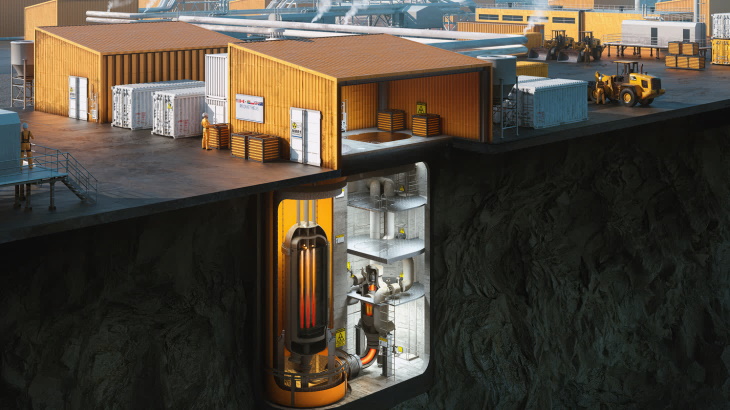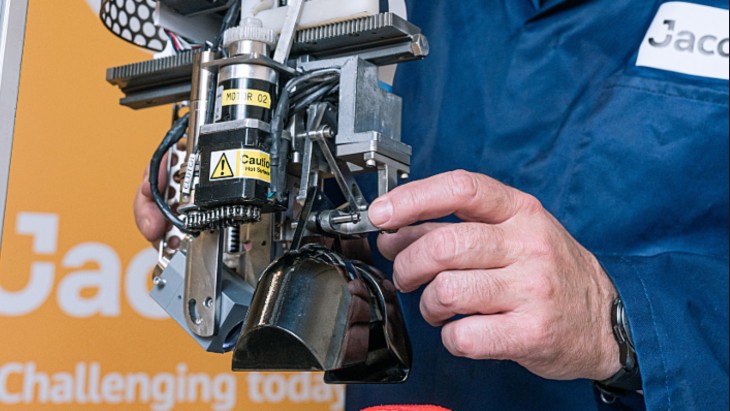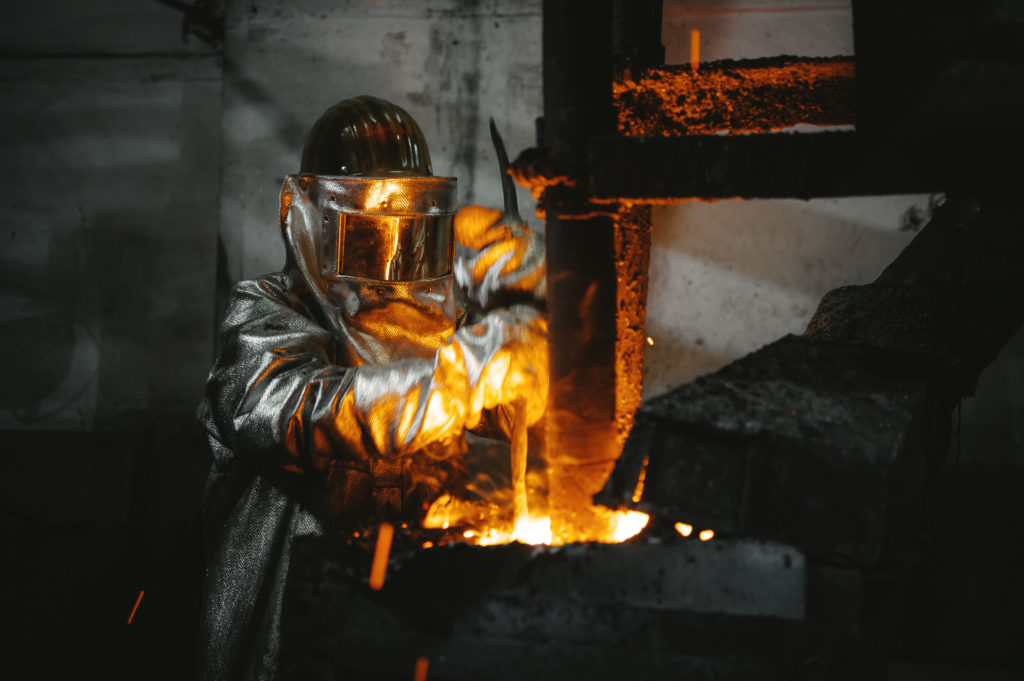INL sees market for microreactors in some US states
24 May 2023
There is high market potential for microreactors in US states with energy-intensive industries, nuclear-friendly laws and widespread social acceptance, according to a new report by Idaho National Laboratory (INL) examining opportunities and barriers for microreactors.
 The Micro Modular Reactor design (Image: USNC)
The Micro Modular Reactor design (Image: USNC)
The report - titled Microreactor Applications in US Markets - provides an evaluation of primarily state-level legal, regulatory, economic and technology implications for microreactor applications in US markets. The initial focus is on the Alaska and Wyoming energy markets serving location-specific energy needs for electricity and heat. A state-by-state evaluation of current carbon/carbon-related policies and nuclear policies is conducted to assess broader market applicability in states undergoing energy transitions.
This work is conducted as part of the Emerging Energy Markets Analysis (EMA) initiative led by INL and includes the University of Alaska, Boise State University, University of Michigan, Massachusetts Institute of Technology and the University of Wyoming.
The report summarises a US Department of Energy (DOE) Microreactor Program analysis of the market opportunities for microreactors. It evaluated several energy solutions for each profile market.
It says that favourable conditions for microreactors include, for example, markets that are cost competitive in electricity and heat, comparable (if not better) in remote locations with diesel sources, and have low-carbon sources including wind, solar, geothermal and energy storage. The use of modular designs allow transport to remote locations by road, barge or rough airstrips. Microreactors can replace coal sites using existing infrastructure. They are suited to areas where transport costs are very high and subject to access restrictions for portions of the year due to weather.
The EMA team examined the regulatory climate in each of the 50 US states in terms of openness to nuclear power, the economic assessment of heat markets that could be important to microreactor adoption, and the potential preferences for microreactor designs.
They found that most states have either removed barriers for microreactor deployment or established carbon-reduction goals that make advanced nuclear technologies attractive. However, challenges remain, such as public perceptions about microreactors' uncertainties in terms of costs, waste and fuel management.
Microreactors are suited for remote industrial applications like seafood processing in Alaska and trona mineral mining in Wyoming, the report says.
"Alaska and Wyoming have their own niche markets, but there is commonality in the remoteness of the applications, mobile uses for microreactors in mining, and energy use for refined products derived from mined sources," said David Shropshire, an INL nuclear energy economist.
The report suggests the nuclear industry and national labs increase communication about the technology and create a clear differentiation between microreactors, small modular reactors and large reactors.
It outlines areas needing further research, including developing a deeper understanding of public acceptance or resistance to microreactors. It says there is also a need to: evaluate other possible microreactor markets including conventional mining, oil and gas extraction operations, carbon refining, ammonia production, synthetic fuels, and other industries; evaluate the cross-jurisdictional regulatory considerations for land use, siting, carbon reduction, transmission corridors and mining; research the regulatory issues associated with industrial use of microreactors, and the access to and interconnection with the grid or the ability to sell excess power into deregulated markets; examine and develop business models for using microreactor heat under different scenarios; evaluate the microreactor supply chain; and evaluate considerations for siting microreactors in northern latitudes.
"Microreactors are a new technology to many of the potential deployment sites, so it is important to promote common understanding of the barriers to market entry for both developers of the technology as well as end users," said John Jackson, national technical director of the DOE Office of Nuclear Energy's Microreactor Program. "The DOE programmes support broad availability of energy solutions to meet individual needs, and characterisation of these needs is very valuable."
US microreactor prototype prepares for testing
23 May 2023
The full-scale replica of the US Department of Energy's (DOE) MARVEL microreactor has been moved from Idaho to a facility in Pennsylvania where it will be used to test the behaviour of sodium-potassium and lead-bismuth coolants.
.jpg?ext=.jpg) PCAT was loaded onto a truck for its journey from Idaho to Pennsylvania (Image: INL)
PCAT was loaded onto a truck for its journey from Idaho to Pennsylvania (Image: INL)The non-nuclear prototype - known as the primary coolant apparatus test (PCAT) - was built at Idaho National Laboratory (INL) and has now been installed at Creative Engineers, Inc's (CEI) facility in Freedom, Pennsylvania, where it will be loaded with sodium-potassium and lead-bismuth coolants for testing to gather data on the system's temperatures and coolant flow. The PCAT will be electrically powered during testing, which DOE said could begin as soon as July.
The Microreactor Applications Research Validation and Evaluation (MARVEL) sodium-potassium-cooled microreactor will generate 100 kW and is expected to begin operation at INL's Transient Reactor Test Facility by the end of 2024. It will be used to develop regulatory approval processes, test microreactor applications, evaluate systems for remote monitoring, and develop autonomous control technologies, and to explore and test microreactor capabilities for applications such as thermal storage, water purification and district heating. It will also be connected to INL's first nuclear microgrid.
-730x730.jpg) The non-nuclear prototype has been installed into a two-story frame at CEI's facility (Image: INL)
The non-nuclear prototype has been installed into a two-story frame at CEI's facility (Image: INL)"Validation of our physics models is critical to nuclear quality assurance for any new reactor development project," MARVEL Chief Design and Project Lead Yasir Arafat said: "PCAT will generate this first-of-a kind-data for validating our thermal-hydraulics simulation tools and quantifying uncertainty for liquid metal thermal reactors, like MARVEL."
The PCAT system is likely to remain at CEI to provide further simulation and testing until the MARVEL microreactor itself begins operation, after which it may be returned to INL to be used for additional research to help advance microreactor technologies.
Fabrication of long-lead components are already underway for the MARVEL microreactor, which DOE said will be the first new test reactor at INL in more than four decades.
Researched and written by World Nuclear News
.jpg?ext=.jpg) The general opinion (Image: OSGE)
The general opinion (Image: OSGE) A robotics specialist at work (Image: Jacobs)
A robotics specialist at work (Image: Jacobs).jpg?ext=.jpg) Darlington 3 reactor face (Image: OPG)
Darlington 3 reactor face (Image: OPG).jpg?ext=.jpg) FEAS researchers Jennifer McKellar, Kirk Atkinson and Xianke Lin, pictured in the university's Energy Research Centre (Image: Ontario Tech University)
FEAS researchers Jennifer McKellar, Kirk Atkinson and Xianke Lin, pictured in the university's Energy Research Centre (Image: Ontario Tech University)




